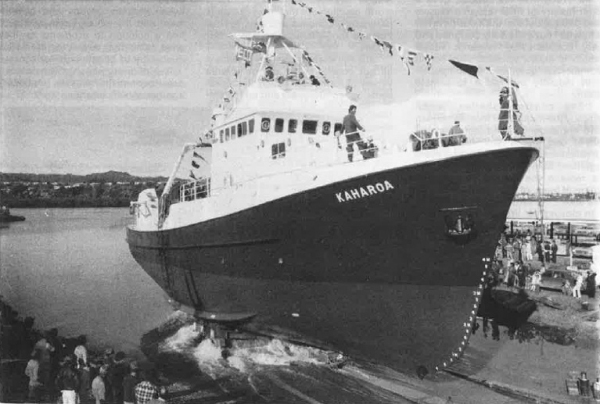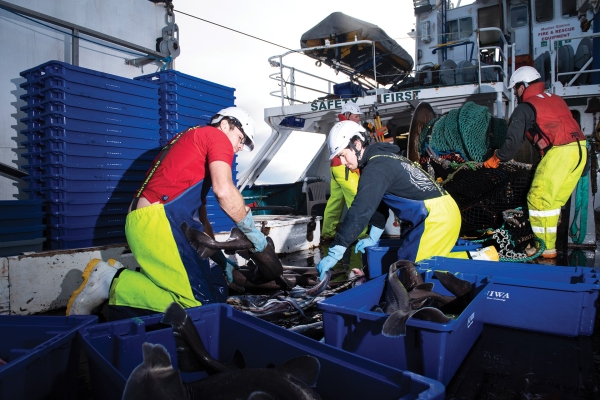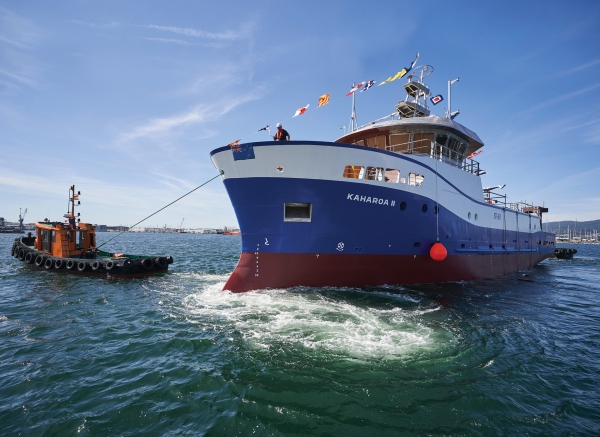NIWA’s long serving Research Vessel Kaharoa is nearing the end of an extraordinarily busy life of science. But, as Ryan Willoughby reports, the next generation already looms large on the horizon.
There are few staff left in offices around NIWA who remember RV Kaharoa being launched in Whangārei back in 1981.
Fewer still remember the remarks on the day by New Zealand’s then Fisheries Research Director, Duncan Waugh, who described it as the smoothest launch he’d ever seen.
Fast-forward 42 years and the brand new replacement vessel, Kaharoa II slides into the ocean for the first time with similar ease. However, this Kaharoa is in a different ocean, half a world away in a shipyard in Vigo, Spain. Nestled up against the wharf, it’s currently undergoing final fit-out and harbour trials, in preparation for its delivery voyage to Wellington early next year.
Kaharoa and NIWA’s RV Tangaroa, are New Zealand’s only dedicated, open ocean research vessels. And after more than 400 voyages, with an average of 200 days at sea per year, it’s time for Kaharoa to make way for the next generation.
The replacement brief from NIWA’s scientists and partners was clear – a state-of-the-art, coastal and ocean-going, multidisciplinary research platform with similar operating costs, but enhanced capabilities. Kaharoa II is the result of six years of planning, from stakeholder engagement to detailed design, construction and launch.
“It’s been the complex project, creating a multifunctional vessel to meet the needs of fisheries, oceanography and a variety of maritime commercial operations,” says Manager – Marine Resources, Rob Christie, who’s been directing the project.
Eight metres longer than its predecessor, Kaharoa II has increased laboratory and deck space, can accommodate more scientists and is able to support a whole new array of technologies and instrumentation.
It is a prospect Dr Richard O’Driscoll, Chief Scientist – Fisheries, relishes. His team spend an average of 130 days per year at sea on the existing vessel, undertaking fisheries research.
“It's great to see all the years of planning turning into reality. Kaharoa II will allow us to continue monitoring the abundance and distribution of New Zealand inshore fish for the next 40 years,” he says.
Affectionately known within NIWA, as 'The Little Ship That Can', Kaharoa has ably supported the work of the significantly larger Tangaroa, working across the Indian and Pacific oceans from Cape Town to Santiago. Kaharoa II will extend the scale of operations.
“Our vessels work as platforms for our science. Kaharoa II will transform what we are able to do, with a broader range of inbuilt capacity and a more flexible layout,” says Chief Scientist – Oceans, Dr Mike Williams.
“We are going to be able to move from an inshore trawl survey one week, to exploring the ocean depths to understand the impact of climate change the next.
“The new vessel will also have the capability to support some areas that were solely Tangaroa’s, such as the deployment and maintenance of the New Zealand Tsunami detection network,” says Williams.
Kaharoa II will also continue to support signature projects like Seabed 2030, an international effort to map the world’s ocean floor, and the Argo programme, a global ocean monitoring initiative involving more than 30 countries. Argo helps researchers understand the complex interactions between our oceans, weather and climate through a global network of nearly 4,000 ocean-going floats providing near real-time measurements of ocean temperature, salinity, currents and biogeochemical data.
Kaharoa has played a key role in this international science collaboration. Since 2001, it has travelled across the southern oceans, deploying over 2,220 Argo floats. About one-third of the world's active floats have been deployed from Kaharoa – far more than any other research vessel worldwide. Fittingly, Kaharoa II’s first job will be adding to the Argo float network in the North Atlantic and the Pacific on its delivery voyage to New Zealand.
Upon arrival, Kaharoa and Kaharoa II will begin a series of joint missions, operating together for two months at sea to intercalibrate fisheries survey methods. This work is needed to ensure the valuable survey time-series built up by Kaharoa over the past four decades, and crucial to New Zealand’s marine resource management, continues.
“I’m super excited to see this vessel arrive in New Zealand. I can’t wait to get on board to start counting and measuring fish," says O’Driscoll.
This story forms part of Water and Atmosphere - November 2023, read more stories from this series



